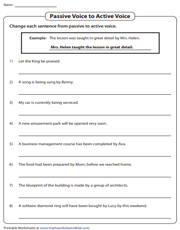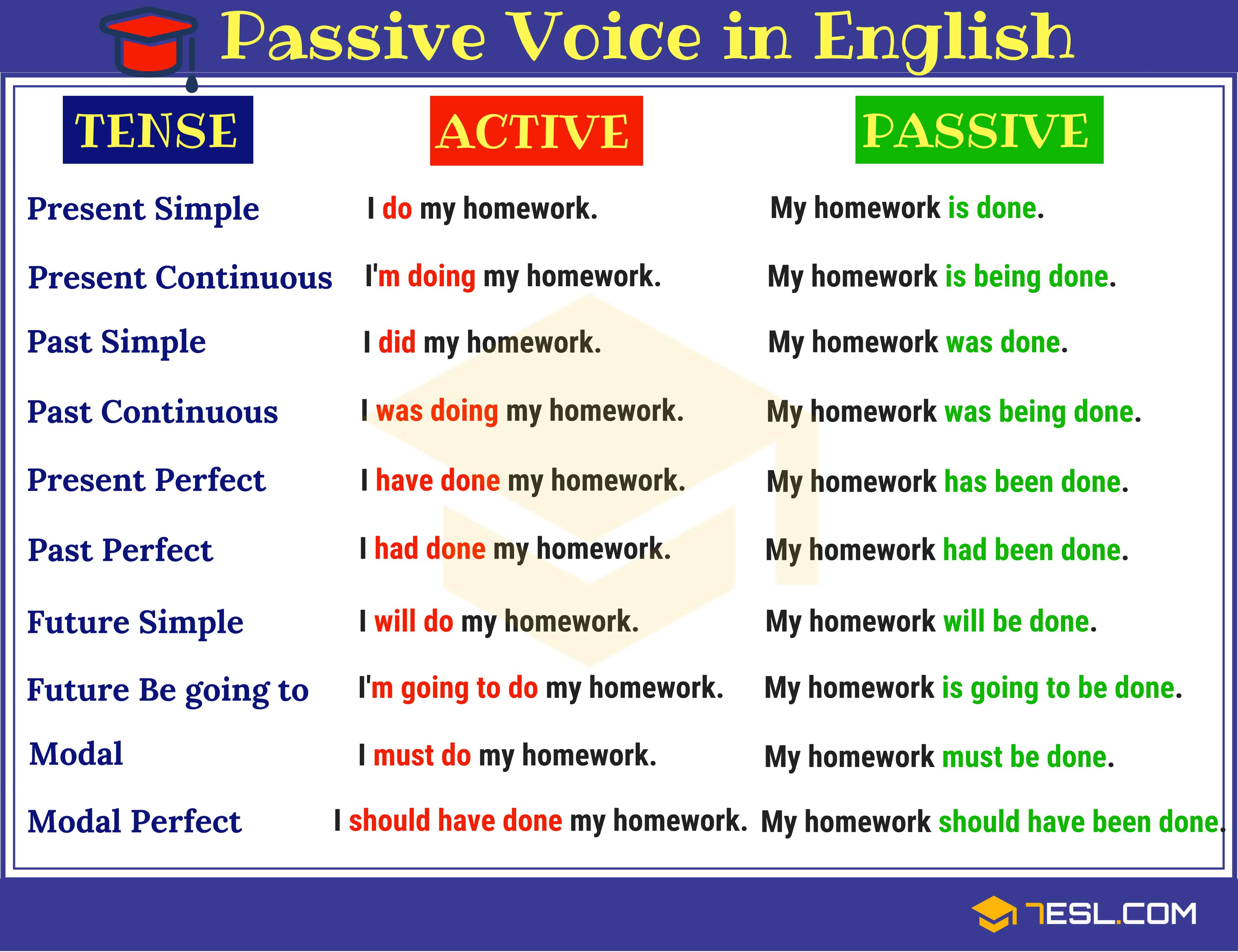Have you ever gotten a paper back from a teacher with 'passive' written in red ink? If so, you may be writing in passive voice without knowing it. Keep reading for quick active to passive voice converter tips and other ways to make voice change easy.
Defining Active and Passive Voice
In the active voice, you will have a subject that will act upon the verb. This means that the subject or noun will come before the verb in the sentence. For example; “the brown fox sat on the mat.” For passive sentences the reverse is true. What Is a Passive to Active Voice Translator? An online tool to detect passive voice sentences and suggest the desired corrections in a piece of writing automatically with the help of predefined software-based linguistic algorithms and grammatical rules is known as a passive voice converter. To convert from a passive voice construction in an English sentence to an active voice sentence, identify the agent or doer of the action and make the agent. A common sentence is an active voice, but when the object is written before the verb and subject is at the end, the sentence becomes a passive voice. Passive voice is usually used when the object is the main focus. However, people use it when the subject is important and overshadow the importance of the subject. Active to passive voice conversion is a daunting task for all types of writers and students, especially those who use English as a foreign language (EFL). It costs substantial money and time for hiring grammar checkers that will catch passive voice mistakes professionally. In such circumstances, an online, free app for fixing passive and active.
You may already know the difference between active and passive voice. But here's a refresher:
- Active voice - the subject performs the verb's action. (For example: Tom changed the flat tire.)
- Passive voice - the subject receives the verb's action. (For example: The tire was changed by Tom.)
Generally, in active sentences, the subject comes before the verb. In passive sentences, the subject comes after the verb. Writing sentences in passive voice can obscure the subject of the sentence and confuse the reader. The good news is that it's quite easy to change the passive voice to the active voice.
Passive To Active Voice Converter Tool
How to Change Voice from Passive to Active
If you can find the subject and verb in a sentence, you change the voice in your sentence. Let's use the following example to understand how to change passive voice to active voice: 'The children were instructed by the teacher.' Use these steps to work your sentence through a passive to active voice converter.
Step One: Find the Action of the Sentence
What action is happening in the sentence? Someone (the subject) is instructing someone else (the object). The past tense verb instructed is part of the verb phrasewere instructed in this sentence.
Step Two: Find the Subject of the Sentence
In passive sentences, the subject may end up at the end of the sentence, or it may be missing altogether. The person instructing, the teacher, comes after the verb. If it were missing from the sentence, it would read 'The children were instructed.'
Step Three: Put the Subject Before the Verb
Once you've found the subject and the verb, put them together. So far, you've got 'The teacher were instructed.' But that doesn't sound right. Fix the verb tense to say 'The teacher instructed.'
Step Four: Put the Object Where It Belongs
Options.ini command conquer generals download. Who did the teacher instruct? The children receive the action (instructing) in this sentence, making 'the children' the object. Put the object right after the verb where it belongs: 'The teacher instructed the children.' Now you have a sentence in active voice!
Getting Rid of Extra Word(s)
Your new sentence is five words long, but your original sentence was seven words long. Where did those extra two words go?
Passive sentences often include extra words to force the subject to the back of the sentence. These words typically include all forms of the verb 'to be,' such as 'was,' 'is,' 'have been,' and 'will be.' Sentences that include the subject may also include the preposition 'by.' Both 'were' and 'by' were unnecessary words in the original sentence.

Practice Changing Passive to Active Voice
Passive To Active Voice Converter Tool
Try a new sentence with the same steps. For example: 'The money has been stolen by the criminals.'
- Find the action (verb phrase): has been stolen.
- Find the subject (who stole it?): the criminals.
- Put the subject before the verb (and fix the tense): The criminals have stolen.
- Add the object (what was stolen?): The criminals have stolen the money.
Now your sentence is in active voice. Correct the following five sentences to practice changing passive to active voice (answers are below).
- The jar is filled by the falling sand.
- Reading is enjoyed by Mary.
- The town was destroyed by fire.
- The room will be cleaned by John every Saturday.
- Cheese was eaten by Sara.
Print a Passive-To-Active Reference Guide
The best way to learn voice change rules is to see lots of examples. That includes examples of both active and passive voice. If you'd like more examples of both voices, download and print the handy reference guide below.
Answers to Practice Sentences
- The falling sand fills the jar. (The falling sand is the subject, fills is the action)
- Mary enjoys reading. (Mary is the subject, enjoys is the action)
- Fire destroyed the town. (Fire is the subject, destroyed is the action)
- John will clean the room every Saturday. (John is the subject, clean is the action)
- Sara ate the cheese. (Sara is the subject, ate is the action)
Be in Control With Active Voice
Feel like you're getting the hang of it? That's great! This is one of the most important rules for English writing. Before you close the book on the subject, learn more about how active voice adds impact to your writing so you're fully in control of your sentence structure. And if you're in need of active to passive converter help, check out those times when it's actually okay to use passive voice.
M.Ed. Education
WATCH: How Do You Fix Passive Voice In A Sentence?
In active voice, the subject performs the action of the verb. In passive voice, the subject receives the action of the verb. If you feel like you need a little more than that, keep reading.
What is passive voice?
The subject of a sentence is the person or thing that sentence is about.
The passive voice is when an action happens to the subject.
In terms of format, passive voice generally combines a form of the verb to be with a past tense verb. In the sentence “Peter Parker was bitten,” for example, the to be verb is was and the past tense verb is bitten. The action (bite) is being performed upon the subject (Peter Parker), so this sentence is written in the passive voice.
Most sentences written in passive voice feature an agent that’s performing the action. Offline bluestack app player setup file (. msi). For example, the above sentence could also be written as “Peter Parker was bitten by a spider.” Here, the agent (a spider) is performing the action on Peter.

What is active voice?
In active voice, the subject itself performs the action rather than having the action performed upon it.
So you can think of this subject as actively doing things. For example, “The spider bit Peter Parker.”The spider is now the subject of the sentence, and performs the main action (bit) on Peter. So this sentence is written in active voice.
In active voice, the object of the sentence (typically a noun that receives the action) comes directly after the verb. Here, the object is Peter. (Sentences written in active voice don’t always need an object.)
Changing passive voice to active voice
To change passive voice to active voice, make the agent of the sentence into the subject, and turn the old subject into the object.
For example, this is a passive sentence: “The article is being read by most of my class.” The agent is most of my class, and the subject is the article.
Written in the active voice, this sentence would be “Most of my class is reading the article.” Here, the new subject is most of my class and the object is the article. Adobe patch zii.
Passive To Active Voice Converter Online

Advantages of passive and active voice
Passive To Active Voice Converter Spanish
Active voice tends to sound more direct in tone because the subject leads the sentence. Asking “Why didn’t you answer your phone?” sounds more direct and authoritative than “Why wasn’t your phone answered by you?” It also makes the sentence sound much more clear.
Passive To Active Voice Converter software, free download
Passive voice works well in instances when the agent is unclear, or when you want to de-emphasize the agent. It’s frequently used in scientific writing to neutralize perspective. This is particularly helpful when describing a specific process, as in “The flask was filled with a transparent solution.”